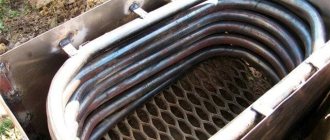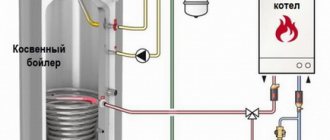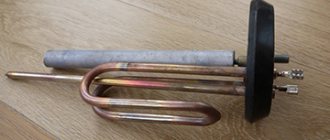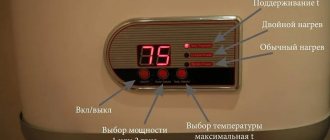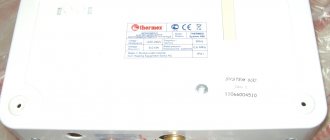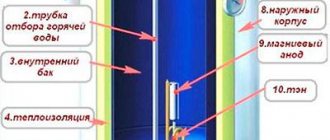Evaluation of indirect water heaters
In the modern world it is very difficult to do without hot water, so most people use boilers.
In stores you can find different types of water heating devices. They come in the following types:
- electric boilers;
- boilers; indirect water heaters;
- gas boilers;
- those that are heated by solar heat.
In this video you will learn how to make a boiler with your own hands:
To heat water in an indirect water heater, you do not need to use gas, electricity or solid fuel. The basis of the manufacture of a hand-made water heater is the use of thermal energy, which is produced by third-party sources. Due to transition heat transfer fluids, heat transport is necessary. Such substances can be antifreeze or water. By using a boiler, you can save a lot of energy resources.
Unfortunately, a water heater has a significant disadvantage: it is not possible to use it at the end of the heating season. Using a boiler during the hottest periods of the year only to obtain hot water is considered an economically unprofitable action. In this case, it is rational to make a combined water heater with your own hands, which, in addition to the heat exchanger, will also be equipped with a powerful heating component.
Causes of scale
In order to clean the water heater less frequently, owners install filters on the incoming water pipe. They trap coarse particles and dirt, but the water hardness remains the same. Modern cleaning systems are not affordable for everyone and they also do not guarantee 100% results. Due to increased water hardness, lime deposits – scale – accumulate in the water heater. A hard crust first covers the heating element, and then the inner surface of the storage tank.
Date: September 25, 2021
How to descale heating elements in a boiler
In order to clean the heating element, you can call professional technicians. Most companies providing services of this kind offer a full package: installation, cleaning, repair.
Highly qualified specialists perform the work as carefully as possible and in the shortest possible time. The only negative is the high cost of services, so many people wonder how to clean the boiler from scale on their own.
Algorithm of actions:
- Disconnect power from the mains;
- Turn off the tap supplying cold water to the equipment;
- Drain the water.
To do this, you need to take a hose and attach it to the safety valve of the device. Place the hose into the toilet or bathtub and wait until the tank is completely empty.
The following steps are followed:
- Removing the decorative protective cover;
- Disconnecting the heating element fastenings;
- Removing the heating element.
The front panel can be easily removed with a screwdriver. Then you should disconnect the wiring and unplug the power cable. It is necessary to unscrew the screws securing the conductors (phase, neutral, grounding).
Next, the temperature relay and sensor are removed and the heating element is removed. All actions must be carried out as carefully as possible. You must first place a large basin under the water heater; residual water and sediment will fall out.
The devices of most water heaters are standard, but some manufacturers create original products, so before descaling the boiler you need to study the instructions, which describe the design of the equipment.
Assembly is carried out strictly in reverse order.
After removing the heating element, its condition should be assessed. In particularly advanced situations, the heating element is so damaged by scale that its further use is impossible. In this case, replacement with a new one is necessary.
Cleaning the heating element is done in two ways:
- Mechanical method;
- Use of chemicals.
Initially, scrape off the resulting upper wet layer with a metal brush. Next, create a solution of organic acid (citric or acetic) in a deep container at the rate of 1 glass of acetic essence (or 200 g of citric acid) per 1 liter of water.
The solution is heated and the heating element is lowered into it for a couple of hours.
Hard deposits will soften and can be easily removed using a regular sponge or rag. Rinse and let dry.
Details on how to clean a boiler at home:
Removing scale from the heating element
So, the water has been drained, the next step is to separate the boiler from the wall. To do this, you will need an assistant, since the capacious Termex unit weighs a lot. You will need to disconnect the tubes, unscrew the nuts and remove the tank from the bracket, lifting it slightly. But now you can place the tank where it is convenient and begin dismantling the heating element.
Follow the steps of work sequentially:
- open the front cover by unscrewing the screws;
- take a photo of the location of the wires;
- disconnect the wiring;
- remove the support flange fastening and remove the heating element;
- Check the condition of the magnesium anode, it may be time to replace it.
The mounting of the heating element in boilers varies depending on the model and manufacturer. The nut on the Ariston heater is unscrewed and the corner is removed. The lid is loosened and inserted into the tank, the heating element is removed sideways. In other models, to remove the element, you need to turn it counterclockwise.
The main part of the contaminants from the heating coil is removed mechanically: under running water with your fingers or a plastic scraper. Citric acid works well against scale. Use a gentle cleaning method: cut off the neck of a plastic bottle and fill it with a solution of lemon juice in hot water, place the heater coil there for several hours. Periodically remove the part and remove the softened plaque.
You can clean it faster if you place the spiral in a deep frying pan with dilute acid on the stove and heat it over low heat.
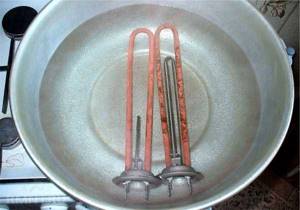
Dissolving scale in acid
How often should boilers be flushed?
Manufacturers always leave operating instructions in the instruction manual. In particular, there is always a point explaining all the nuances of cleaning procedures. The BKN must be cleaned on average once a year if there are no serious breakdowns that affect the proper operation of the equipment. There may be a stench reminiscent of rotten eggs when using warm or hot water. Also a sign may be a decrease in temperature for heating water and the appearance of rust. If you find any of these signs, then you urgently need to stop further operation of the equipment and carry out maintenance. The frequency of cleaning procedures is influenced by the following circumstances: Output quality.
How to clean a boiler with your own hands
You can descale the heater at home with your own hands or invite a service representative. The designs of different boiler models are different, but the technology has the same algorithm.
There are two common cleaning methods:
- Chemical, not requiring disassembly of the device, using industrial liquid. Many craftsmen clean the boiler with their own hands, using homemade cleaning products with citric acid.
- Mechanical method. Before cleaning the Ariston boiler at home using this method, you will need to disassemble it. Clean the heater and tank at the same time. This is a complex, labor-intensive method and is advisable to use if chemistry does not give the desired effect.
Before descaling the boiler, perform the following preparatory operations:
Turn off the voltage to the boiler and close the water supply tap. Remove the panel and power terminals. Disconnect the grounding and electrical wire. First, take a photo of the electrical circuit in order to assemble it correctly in the future. Before cleaning the Ariston water heater, drain the water, having previously prepared vessels and hoses to drain the water into the sewer system, with the least amount of spillage in the room. After the cranes empty the storage tank, disconnect the fastenings and dismantle it. If there is no drain valve, drainage is performed through a safety valve. Considering its small cross-section. The process will be lengthy. Before cleaning the heating element, unscrew the bolts and remove the flange with the heating element.
For wall-mounted models, the housing is removed from the mounts and carefully placed on a clean surface with the taps facing up. Loosen the clamping clamp and take out the electric heater.
Chemical method
This is the simplest method and can be done without disassembling the unit. Such preventative cleaning of the boiler prevents the deposition of difficult-to-remove scale. The method is based on the use of a descaling agent, for example, an aqueous solution of vinegar or citric acid.
The best cleaning products
There are chemicals, reagents and special equipment suitable for preventive maintenance. Some deposits can be easily removed without disassembling the boiler. In more complex cases, you will have to unscrew the connecting elements.
Service centers use household and industrial pumps that easily clean parts. It is not profitable for a simple user to buy such a unit for personal purposes.
To replace the pump with something, more accessible ways were invented to clean the water heater from scale:
- Acetic or citric acid. They are always at hand and can easily cope with not very old scale. To effectively clean elements with citric acid, it is important to carry out preventive maintenance on time. Many people use this method because it is easy to implement and inexpensive. It is impossible to damage any elements with substances if the ratio is carefully measured.
- How to clean a water heater with sulfamic acid? Turn on the heat to 60°C, add a portion of granules and make sure they dissolve there. The resulting liquid removes dirt and plaque very well. They love acid because it can be found in any hardware store and is cheap.
The best way to protect yourself from unnecessary expenses is to have your water heater serviced annually. The check will determine whether there is rust or leaks, and whether thermostats and valves are working properly. Washing the tank can be done more than once a year, but more often. It all depends on the composition of the water in your area. If you find out how to flush an indirect heating boiler yourself, you will get great savings over time.
Do-it-yourself cleaning of water heaters from odor inside
Many owners of water heaters notice over time that the heated water begins to smell terribly. This unbearable smell may have several reasons:
- Dirty water is supplied to the boiler. If there are a lot of foreign impurities in the water, especially hydrogen sulfide, it emits an unpleasant odor.
- There are specific bacteria and fungi in the tank. Such living creatures are born in the limescale deposits on the walls of the container. As long as there are not many microorganisms, the smell of the water does not change. But over time, their number increases, and the water begins to stink.
- Cheap or damaged water supply. Low-quality tubular plastic transfers its chemical smell to water. And old metal water pipes are ideal for the life of bacteria and fungi.

Water with hydrogen sulfide is impossible to smell
There is a way to determine which of these cases occurs:
- Run cold tap water for 5 minutes. Then place a clean bottle under the stream and close it after filling. After half an hour, you need to open the bottle and check the smell of the water. If it smells bad, there is a problem with the pipes or water.
- If cold water from a bottle smells normal, you need to look for the reason in the boiler itself. To do this, you again need to fill the plastic container, but only from the hot tap closest to the water heater. We wait 30 minutes and smell. If you can’t breathe from the bottle, it means there are harmful microorganisms in the tank.
In order to eliminate the unpleasant odor due to bad water or rusty pipes, you can do the following:
- Install a filter that removes bad-smelling gases from the water.
- Complain to the SES about the poor quality of tap water.
In the first case, you don’t have to wait for someone to come and fix the problem. Therefore, if you can’t stand the smelly water, it’s easier and faster to install a filter.
Problems with microorganisms in the boiler are solved differently:
- Sterilization of the tank. The water in the boiler is brought to a boil and remains in this state for a long time.
- Removing scale from a water heater (see above). This will destroy the favorable environment for the proliferation of microbes and bacteria.
To prevent smelly water from coming out of the boiler again, you need to follow simple preventive measures:
Do not leave water in the water heater when it is not in use for a long time. Periodically descale the tank. It is advisable to install a filter
Pay attention to water quality. If necessary, contact the sanitary and epidemiological station
The anode is not the same
Almost every boiler has a magnesium anode installed. Its task is to prevent corrosion of the internal tank, especially the welds. Moreover, this process does not arise from the water itself, but from the substances dissolved in it.
Over time, the anode wears out and must be replaced. If this is not done in time, the water may have a metallic taste and smell. The only solution in this case is to flush the boiler and replace the anode.
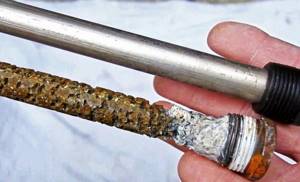
New and exhausted magnesium boiler anode.
Expert advice
Sometimes the cause of the smell may be a poor-quality heating element or anode. If the smell or taste in the water reappears after cleaning, this may be the problem.
To avoid problems with scale, perform maintenance on your boiler once a year.
If you have dirty water from a water supply system, a well, or a borehole, place a filter in front of the boiler entrance and periodically change or clean it.
Do not heat the water below +55 degrees. At a lower temperature, microorganisms will multiply in it, especially the dangerous Legionella.
If your water heater tank is made of stainless steel, paint the welds with enamel. This is the weakest point of such boilers.
Install a back pressure valve. It will bleed water if the pressure in the system is too strong or a water hammer occurs. This way you will protect yourself from surprises.
The boiler is dirty: how to tell
To determine whether it’s time to clean your equipment or you can wait a little longer, you need to pay attention to some facts.
Reasons to think about boiler cleaning:
- there are extraneous noises when the equipment is operating;
- The water takes too long to heat up;
- increased electricity consumption when operating the water heater;
- the color of the water has changed;
- unpleasant odors appeared.
These indicators indicate that the problem already exists and it is time to clean the system. To avoid heavy deposits and deposits, softeners and filters must be used. Manufacturers are ready to offer several product options suitable for any boiler. If you have very hard water, it is better to buy an ion exchange softener and magnetic filters.
Cleaning the boiler from scale
The cleaning process is not very difficult. Despite the fact that boilers from different manufacturers have their own design features. All devices of this type have the same cleaning procedure algorithm. To work, you will need a screwdriver, a wrench, a screwdriver and a special cleaning agent.
The whole process involves the following steps:
- Disconnecting the device from the power supply.
- Shutting off the cold water supply.
- Removing the boiler cover and then disconnecting the wires.
- Removing the thermostat.
- Draining.
removing the boiler cover
In order to drain the water, a tube or thin hose of short length is used, which is installed at the collection outlet, not far from the place where the safety valve is located. In order for air to enter the check valve, you need to open any hot water tap. The water is drained through the tube into the sink or toilet. If the safety valve is damaged or does not function, its subsequent replacement is required. In this case, first turn off the cold water supply and disconnect the supply hose. After this, connect the tube to the ball valve. Then drain the water from the boiler. To unscrew the nuts holding the flange plate, you must first place a basin so that the remaining water does not spill out onto the floor. Then push the flange up. After which it is turned over and taken out. It is necessary to remember the original location of the flange so that during reassembly you do not put it “upside down” and do not confuse the location of the terminals.
removing the heating element
For cleaning, you can use vinegar and special cleaning fluids. By the way, you can even clean your washing machine with citric acid and vinegar - a kind of universal remedy, not a food additive. In this case, you need to act carefully so as not to scratch the surface of the heater. You should not chip away scale from the walls of the tank using a knife, scissors or other sharp objects, as this can damage the protective layer.
After the heating element has been disconnected, you need to clean the inside of the tank from accumulated dirt with a rag. If it is covered with enamel, then there may be little scale on the walls. It is better to remove scale from the bottom of the tank with your hands (you can wear rubber gloves). After removing dirt, the tank is washed with a stream of water and wiped dry.
The entire disassembly and cleaning process is presented below in the video:
Mechanical cleaning of the device’s water heater with disassembly
If the boiler is heavily soiled, the only way to descale the boiler is mechanically. The water heater will have to be disassembled. This is done carefully so as not to damage the electronic unit and heating element, otherwise there is a risk of a short circuit. The process consists of two stages: cleaning the heating element and the storage tank of the water heater.
To descale the device mechanically, you will need to dismantle the water heater. After disconnecting the device from the network, proceed to disassembly:
- first close the cold water supply tap, then disconnect the pipeline from the boiler fitting;
- the storage tank is emptied through a mixer or an additional drain valve;
- disconnect the hot water pipeline from the boiler fitting;
- remove the lower decorative cap by unscrewing all the screws;
- if the handle of the mechanical thermostat protrudes, it is also removed;
- use a screwdriver to unscrew the contacts that clamp the power wire;
- the boiler is removed from the wall and placed upside down in the bathtub;
- the flange with the heating element and the thermostat are unscrewed, removed from the tank, and then mechanical cleaning begins.
The procedure for dismantling boilers from all companies is almost the same. Some nuances of attaching the flange and decorative cap may differ.
Cleaning products and tools
To descale your water heater you will need the following tools:
- adjustable wrench and set of wrenches;
- straight and curved screwdriver;
- pliers;
- knife, sandpaper.
Cleaning products for descaling are bought in the store. A solution is prepared from citric acid by dissolving 500 g of crystals in 2 liters of water. Instead of citric acid, you can dilute 40 ml of vinegar in the same amount of water.
Cleaning the heating element
When disassembling for the first time, a person does not know how to clean the heating element of a water heater so as not to damage it. You will need to be careful in your work. You need to know that the heating element of a water heater comes in wet and dry types and they are cleaned in two ways.
Wet heating element
Mechanically descaling the heater can be done by scraping it with a knife. Thick growths are crushed with pliers, and the remains are rubbed with sandpaper. You cannot overdo it so as not to damage the copper shell of the heating element.
If you feel unsure, it is better to place the heater in a cut-off plastic bottle filled with a solution of water and citric acid. Approximately 5–6 hours after the scale has completely dissolved, the heating element is removed and washed with clean water.
Dry heating element
Dry heating elements are handled with care. Do not scrape, break or rub hard accumulations with sandpaper.
Dry heating elements can only be cleaned chemically by immersing them in a solution of citric acid or a factory-made cleaning agent.
When cleaning the heater, inspect the magnesium anode. If it has worn out and become thin, then replace it.
Cleaning the storage tank
To remove dirt or scale from the walls of the water heater storage tank, do not resort to rough action. Sandpaper or scrapers will damage the protective coating. The mucus is simply washed out with a soft sponge, using water under pressure from a shower head.
If there is a thick layer of scale on the walls of the water heater tank, use a factory-made cleaning solution. Citric acid or vinegar diluted with water will do. The water heater tank is filled with solution and left overnight. In the morning, the liquid with the fallen plaque is drained. The tank is washed with clean water.
Reassembling the boiler after cleaning
After cleaning and disassembly is completed, the water heater is reassembled. All actions are performed in reverse order:
- The thermostat with heating element is put in place and the flange is screwed on;
- the boiler is hung on the wall;
- cold water and hot water pipelines are connected to the nozzles;
- the storage tank is filled with water and tested under pressure to ensure there are no leaks;
- if the test is successful, connect the electrical cable, put the decorative cap in place, and then try to heat the water.
During reassembly of the water heater, it is important to carefully inspect the gaskets. They are well cleaned from dirt, but it is better to buy new ones
To prevent leakage, the gaskets are lubricated with sealant.
Signs of scale in a water heater
- Noise appears during boiler operation. Typically, this electrical equipment operates almost silently, but scale can lead to unusual sounds and humming when heating water;
- The process of heating the water to the set temperature begins to take longer. Electricity is consumed, but the heating elements cannot heat the water properly due to the layer of solid deposits;
- The boiler begins to turn off more often to prevent overheating.
Stages of descaling the boiler:
- First of all, the electrical device is disconnected from the network. The safest thing to do is not just unplug the plug from the socket, but also turn off the machine and disconnect the wires from the thermostat.
- It is advisable to wait until the water in the tank cools down a little, it will be safer to work this way.
- The water supply valve to the boiler should be turned off to prevent the boiler from filling.
- The water from the tank must be drained, following the instructions for the boiler or the water supply diagram through the boiler.
- So, the boiler is empty, the water has been drained. Now you need to get to the heating element. To do this, first of all, the decorative cover of the tank is removed; it is usually secured with several screws. You will need a screwdriver. Let us clarify: for most standard vertical models of water heaters, you can remove the heating element directly on the wall, without removing the boiler itself from its mounts. However, for example, if you have a flat model mounted horizontally, it will be inconvenient to work with. In this case, after draining the water, it is advisable to remove the tank and move it to a place where you will be comfortable working with it;
- For some models, the thermostat is removed together with the heating element, for others it is pulled out of the housing;
- There are models in which the entire stand with heating element is held on by just one nut, so it will not be difficult to remove. Other models have more nuts - five or six, but in any case they must be unscrewed to get to the heating element.
- For ease of operation, the heating element removed from the water heating tank should be unscrewed from the lid on which it is installed. First of all, we wash the heating element under cold water to wash off the top layer of scale, possibly rust;
- The remaining plaque will have to be removed differently. The simplest chemical method is to soak the heating element in water with dissolved citric acid. Remember that citric acid is recommended as a folk remedy for preventing the appearance of scale in a washing machine. She copes well with the raid. To clean the heating element, citric acid should be diluted with water in a proportion of 10 grams (one sachet) per liter of water. The heating element is simply soaked in this solution for a while; check its condition periodically. To increase the effect, the citric acid solution should be heated;
- It is not recommended to clean hard, petrified deposits from the heating element with a knife - there is a risk of damaging the top layer if you are too zealous. If you decide to use a mechanical method, you can use sandpaper, but you should also act carefully;
- Instead of citric acid or vinegar, as folk remedies, heating elements can be cleaned with special anti-scale chemicals;
- The tank itself should also be washed. If you removed it from the wall, you will have to fill it in and then pour it out manually. If it still hangs in its place and it’s convenient for you to work, then simply turn on the water supply, but do not close the hole from where you pulled out the heating elements so that the dirt pours out immediately. You should walk along the walls of the tank with a rag to remove deposits. The inside walls of the boiler are enameled, there is no scale on them, but dirt may remain;
- Abrasive substances should not be used when cleaning the tank so as not to damage the walls;
- After cleaning the heating element and the tank, you should assemble the boiler - everything happens in the reverse order. The main thing is to securely tighten the connecting screws and nuts, install the thermostat, use a pipe wrap, connect the wires;
- Then we turn on the water, fill the boiler and connect it to the network to check how it will now work. Published by econet.ru If you have any questions on this topic, ask them to the specialists and readers of our project here.
How to clean a water heater
After you have determined the characteristics of the equipment, you can start washing:
- Turn off the cold water.
- Turn off the thermostat. Some water heaters have a special mode. The goal is to keep the heater from turning on after all the water has drained, especially for gas installations. Before restarting, also turn off the fuel supply.
- Take a garden hose and attach it to the drain valve at the bottom of the tank. Place the other end of the hose outside or into a drain hole in the house. If you choose the first option, check that water does not flow under the foundation.
- Turn off the hot water tap all the way so that it flows out of the tank faster.
- Open the water heater tap and drain the water from the tank. If you open the drain valve and nothing comes out, it may be clogged with sediment. Then raise the emergency temperature release lever. Next, using a vacuum cleaner (any one is suitable - for wet or dry cleaning), try to remove the clog from the drain valve. Wear gloves and be careful.
- Now run cold water into the tank and wash away any sediment that may have remained at the bottom. Wait a couple of minutes and see what color the water comes out of the hose. If it is no longer cloudy, turn off the supply.
- Remove the hose and use a wet vacuum to remove any sediment from the drain hole.
- Leave the taps open and wait for the water to flow. This must be done to prevent air from entering the tank. If you see rust or sediment, don't be alarmed. After a few minutes the water will be clear, then close the taps.
- Set the boiler thermostat to your desired temperature. Once the tank is filled, it should take about 20 minutes for the water to heat up, although this depends on the model of heater you have and whether you use natural gas or electricity.
How to choose an indirect heating boiler
Making the right choice of the appropriate indirect heating boiler model is a difficult task for a beginner. However, there is nothing overwhelming here, you just need to take into account a few important nuances:
When choosing an indirectly heated water heater for an apartment or private house, the first step is to determine the optimal volume of the storage tank. To ensure that there is enough hot water for all family members, it is calculated taking into account the approximate consumption of 100 liters per day by one person. An indirect water heating boiler is economically beneficial for a family of four or more people
With this number of people, the approximate DHW consumption is 1.5 l/min. Paying attention to the volume of the tank, take into account the heating time. A larger container will take longer to heat up. It may be worth giving preference to a model with two heat exchangers or a tank-in-tank system. The composition of the thermal insulation determines how long the water will remain hot after the boiler is turned off.
Cheap water heaters come with foam rubber. The porous material retains heat poorly and quickly decomposes. The optimal thermal insulation is mineral wool or polyethylene foam. To make the right choice, you need to compare the power of the indirect water heater and the heating boiler. If the latter is characterized by weak parameters, the boiler will become an unbearable load. When buying any model, be sure to pay attention to the presence of a thermostat, valve and other safety elements.
It may be worth giving preference to a model with two heat exchangers or a tank-in-tank system. The composition of the thermal insulation determines how long the water will remain hot after the boiler is turned off. Cheap water heaters come with foam rubber. The porous material retains heat poorly and quickly decomposes. The optimal thermal insulation is mineral wool or polyethylene foam. To make the right choice, you need to compare the power of the indirect water heater and the heating boiler
If the latter is characterized by weak parameters, the boiler will become an unbearable load. When buying any model, be sure to pay attention to the presence of a thermostat, valve and other safety elements.
When all the important nuances have been resolved, you can pay attention to the form, design, manufacturer and other details
Calculation of storage tank volume
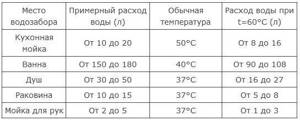
To make an approximate calculation of the volume of the storage tank, you can use a simple reading of the water meter. When the same number of people constantly arrive in a house, the daily consumption will have the same data.
A more accurate calculation of volume is based on counting water points, taking into account their purpose and the number of living family members. In order not to go into complex formulas, hot water consumption is taken from the table.
Connection diagrams to the heating system
When choosing a connection diagram for an indirect boiler for heating water, take into account the location of the device in the house, as well as the wiring features of the heating system.
A simple and frequently used circuit is based on connecting an indirect device through a three-way valve. As a result, two heating circuits are formed: heating and hot water. After the boiler, a circulation pump is installed in front of the valve.
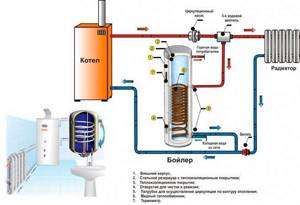
If the need for hot water is small, a system with two pumps is suitable. The indirect water heating device and the heating boiler form two parallel heating circuits. Each line has its own pump. The scheme is suitable for country houses where hot water is rarely used.
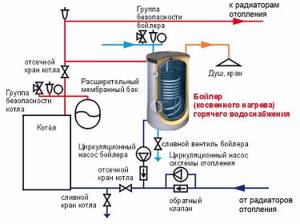
The connection diagram becomes more complicated if a “warm floor” system is installed in the house along with radiators. To distribute pressure along all lines, and together with the indirect boiler there will be three of them, a hydraulic distributor is installed. The unit normalizes water circulation through the “warm floor”, water heater and radiators. Without a distributor, the pumping equipment will fail.
Indirect water heating devices with recirculation have three pipes coming out of the body. Traditionally, two outputs are used to connect to the heating system. A looped circuit leads from the third branch pipe.

If the indirect water heating device does not have a third pipe, and recirculation needs to be done, then the return line circuit is connected to the cold water pipe and an additional recirculation pump is installed.
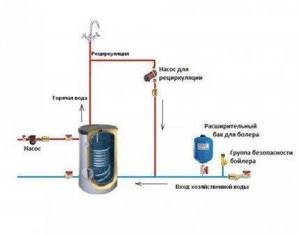
Recirculation allows you to get hot water at the outlet of the tap even before the liquid in the boiler storage tank is completely heated.
Details
Cleaning the heating element of a water heater from scale without disassembling
It is not always possible to disassemble a water heater in order to carry out deep mechanical cleaning. This process is labor-intensive and complex. To disassemble a large boiler, you need the help of one more person. As a preventive treatment or first aid, you can use special products that can dissolve scale and clean the heating element from contaminants.
How to remove scale from a water heater using professional products
Water that flows through a rusty water pipe should be used with products containing phosphoric acid. According to the recommendations of experts, it is better to use the following means:
— Aipakon;
— Cillit ZN/I;
— Thermagent Active;
— AlphaPhos.
REFERENCE! Equipment that has been in use for more than 2-3 years should not be cleaned with products based on other acids.
The insides of the boiler can be cleaned using surfactant-based products. The most effective are Alumtex and Steeltex.
Before using the products, you must carefully study the instructions for descaling the boiler. The manufacturer usually indicates the exposure time on the packaging.
Usually the solution still needs to be prepared, that is, the product must be mixed with water in the required proportions. Then you need to open the cold water supply to the water heater and drain hot water by 60-70 percent. By connecting the boiler back, you need to pour the prepared solution inside the tank. Then you need to leave the product for 5-6 hours and drain it through a running hot water tap.
Cleaning a water heater from scale at home using folk remedies
If you were unable to buy a specialized product for some reason, you can try using improvised means. You can descale heating elements using vinegar or citric acid.
To prepare an active solution, you need to dissolve 0.5 kg of citric acid in two liters of water. Empty the tank 1/3, and pour acid inside. The tank should be left in this state overnight. During this time, lime deposits and rust should dissolve.
REFERENCE! The inside of the boiler is protected by thin enamel, which can be easily damaged by aggressive chemical compounds.
Disassembling the boiler and cleaning the heating element
Experts advise completely disassembling small units to clean them of scale. In this way, you can return them to their original efficiency indicators.
To clean the water heater from a layer of scale, it must first be disconnected from the power supply and shut off the flow of cold water. Then you need to wait 2-3 hours so that the water temperature decreases and the person does not get burns. Then you need to open the hot water tap and empty the tank.
Then you should remove the scale as follows:
- The hot water supply hose must be disconnected and the corresponding tap on the mixers must be opened to allow the residue to drain out.
- Disconnect the power cable from the thermostat and heating element, working carefully.
- Gradually unscrew the flange to which the heating elements fit and allow the remaining water to drain. After which it must be completely removed.
REFERENCE! Now is the time to take a photo of the internal connection of the boiler, so as not to get confused in its electrical circuit later.
The heating element that has been successfully removed must be descaled. This must be done with a sharp object. A knife, chisel or other object with an abrasive surface will do.
Be careful not to damage the tube.
The storage tank must be cleaned of mucus and other contaminants using a brush or plastic scraper. In this case, you should not put pressure on the housing or rub it hard, as this can lead to a leak or damage to the walls.
After the descaling work has been carried out, you need to reassemble the boiler in the reverse order of disassembling it.
Before installing the boiler in place, it is recommended to clean the rubber parts of the boiler and treat them with sealant. Using this technique, you can avoid water leakage during operation of the water heater and reduce the risk of scale formation.
After installing the heating element in place, you need to do the following:
- Hang the boiler in place.
- Connect it to the pipeline.
- Open the cold water supply and turn on the hot water tap.
- Wait until the boiler is filled with water and check the tank for integrity.
- Reinstall the thermostat and connect the wires.
- Reinstall the safety valve.
- Plug in the boiler.
REFERENCE! If the boiler is regularly cleaned of rust and scale, then this process will not take much time, due to which the service life of the device will be extended.
Cleaning technology
The frequency of cleaning the boiler depends on its operation and the quality of the water at the place of use. In this case, you need to follow a certain technology.
Draining
Before descaling a water heater at home, you need to drain the water from the tank. This can be done in several ways.
Please pay attention to the following details:
- The water should be cold when draining. There is a risk of burns when hot water leaves the boiler. The boiler must be turned off at least 1 day before scheduled cleaning.
- Before draining, disconnect the boiler from the power supply and close the water supply from the water supply to the heater.
- In addition to water, particles of contaminants will flow out of the tank. Therefore, it is inappropriate to drain it into a bathtub or sink.
How to drain the water
As mentioned above, there are several ways. The fastest option is to remove the top cover, disconnect all the parts, allowing access directly to the tank. Water can be used in a bucket or other container. This is the fastest way.
Another option is the classic drain through a safety valve and water tap. Open the tap to the maximum, loosen the safety valve. The water will drain slowly. Place a bucket or other large container under the safety valve and constantly monitor the amount of water.
Disassembling the boiler
Before descaling the boiler, it must be disassembled. It's relatively easy to do it yourself:
- remove the heater cover;
- remove all electrical parts (for example, heating element, thermostat);
- Place a container under the device (in case all the water has not drained out).
Cleaning the heating element
Few people take into account the fact that cleaning an indirect heating boiler or removing deposits from a direct heating device is not enough. The thermostat and heating element (tubular electric heater) also require cleaning. This is especially true for areas with too hard water, where not only the tank, but also other parts become covered with water stone, and the pipe supplying water becomes clogged.
The first option to clean the heating element of a water heater is mechanical removal of deposits. But this method of getting rid of scale and rust can damage the device.
It is safer to clean the heating element with citric acid. The main thing is to do it right:
- prepare a warm solution of 2 liters of water and 20 g of citric acid;
- place the heating element in the solution, leave to soak in acid for 24 hours;
- rinse.
Cleaning the tank
Cleaning the boiler tank at home:
- Drain the water (see point above).
- If the water stone is soft, it can be washed off, cleaned with water or wiped. If there is a thick coating, clean it with a wooden scraper. Do not damage the enamel while cleaning! Small areas covered with waterstone can be cleaned by immersion in vinegar water.
- Replace all worn parts, especially seals, magnesium anode (its service life is about 2 years; this is an essential part of the boiler, protecting the inner casing and gradually dissolving). Do not reinstall damaged or rusty parts. The enamel must be in perfect condition.
Elimination of odors
The smell of hydrogen sulfide from the boiler is more likely to relate to the water rather than the heater. Sometimes the water contains large amounts of sulfate along with bacteria. These harmless bacteria in stagnant waters deprived of oxygen produce hydrogen sulfide gas using the hydrogen ion from the anode protection.
If the hot water smells unpleasant after heating, it is recommended to increase the heating to maximum for 2-3 days, and then set the temperature to a lower temperature (45-50 °C). The odor can also be reduced by replacing or removing the anode.
Boiler assembly
After checking all the parts, cleaning process, replacing all faulty parts, everything is reassembled in the reverse order of disassembly. Do not replace damaged parts (rusty, etc.). All parts must be smooth with a clean surface. Otherwise, you risk repeating the cleansing process in just a couple of months.
Descaling
After draining the water, close the drain, pour in dissolved citric acid (warm solution), fill the tank with water to ½ volume, close the cold water. Turn on the heater, leave it on from morning until evening (reducing the time is not recommended) or overnight. But sometimes you have to add water.
After cleaning, pour out the acid, rinse the tank at least 3 times (rinse until only clean water comes out).
Assembly technology
We will describe step by step how to make an indirect heating boiler with your own hands - the whole complex of work will consist of the sequential assembly of different parts of the structure.
Water heater tank
The volume of the container into which water will flow for subsequent heating depends on the needs of the homeowner: the standard consumption is up to 70 liters per household per day, so for a family of 4 people 200 liters will be enough.
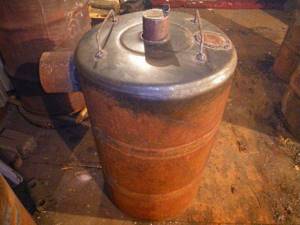
The material of the tank should be selected from an aluminum alloy, as well as other non-ferrous metals that are not subject to corrosion, if finances allow - stainless steel. A good alternative is a gas cylinder, but the inner walls must be treated with a special primer, otherwise the hot water will have an unpleasant rotten smell.
You need to cut at least 5 holes in the tank body with your own hands: two on either side - they are intended for inserting a coil, at the bottom there are also 2 - for water supply and a drain tap, at the top there is only one - hot water extraction.
Making a coil
This element, made of a copper pipe of small diameter but thick-walled, can necessarily have different dimensions - it depends on the volume and height of the container. Experts say that for every 10 liters. water requires 1.5 kW of coil thermal power.
To save money from your home budget, you can use pipes made of a different material, but always with excellent heat transfer. During manufacturing, it is necessary to carefully monitor the formation of turns:
- they do not touch under any circumstances - there must be a gap between the turns;
- do not make excessive efforts - this will make it very difficult to remove the finished product from a special mandrel;
- the number of turns is strictly calculated and depends on the dimensions of the tank.
For the mandrel, use a pipe of the required diameter or a round wooden log without knots. After manufacturing, the spiral is carefully coated with a protective heat-resistant varnish.
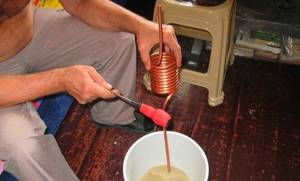
We insulate the structure
The outside of the tank must be covered with thermal insulation to reduce losses and increase the efficiency of the product - this can be special foam for installation or other material with excellent thermal insulation properties, for example, polystyrene foam.
It is secured with wire, special ties or glued on. Craftsmen recommend strengthening sheets of foil on top of the insulation or using insulation with one foil side. Some craftsmen insert the boiler into a larger container for insulation, and fill the space between it and the inner walls with insulation of any kind.
Cleaning Methods
Before cleaning the water heater, you will have to figure out how to remove scale.
No disassembly
Some people believe that to clean the boiler it is necessary to flush it, but this is not so. You can get rid of plaque on the walls without disassembling the device. To do this, pump out all the water from it and pour a solution made from water and citric acid inside.
Tool
Before you start disassembling the equipment, you need to prepare the tools that can be used for this. To complete the work you will need the following:
- a screwdriver with a built-in indicator for checking wire voltage;
- a regular flat-head or Phillips screwdriver to unscrew the fasteners;
- scissors;
- a set of keys;
- a rag or sponge for wiping the boiler.
TOP 10 products that can be used to clean water-based paint at home
Draining
Before cleaning the water heater, be sure to drain the water. To do this, perform the following steps:
- disconnect the equipment from the power source so that the water tank has time to cool down;
- turn off the tap responsible for the supply of cold water;
- open the hot water and wait until it completely drains into a bucket or other empty container.
DIY disassembly
Before disassembling the equipment, it must be carefully removed from the wall on which it is suspended. To do this, remove all fasteners, after which the tank is placed on a flat surface with the taps facing up.
When the water heater is removed, you need to remove the heating element and thermostat from it. To do this, you need to loosen the bracket a little and remove the parts.
Methods for cleaning heating elements
There are two methods for cleaning heating elements that will help quickly remove traces of scale.
Mechanical
A large layer of scale that has accumulated on the product for several years is removed mechanically. To do this, you can walk across the surface with a knife or other sharp object. When there is little plaque left on the heating element, wipe it with a damp sponge soaked in a soap solution.
Chemical
Some people are afraid to clean the heating element mechanically, so as not to accidentally damage its surface. In this case, it is necessary to use a chemical descaling method. The product can be soaked in a solution prepared from chemical detergents or citric acid. Soaking should last 2-3 hours, after which the scale can be wiped off with a cloth.
Cleaning the tank
Cleaning the tank from dirt is very simple. First you need to manually scrape out all the scale that has accumulated at the bottom. Then the walls of the container are washed with strong water pressure so that the largest pieces of scale break off.
Elimination of odors
Sometimes an unpleasant odor appears inside the tank, which you will have to get rid of. To do this, drain the liquid from the container and fill it with clean water. Then the water is heated to maximum temperature, after which it is drained. The procedure is repeated until the unpleasant aroma disappears.
10 most effective ways to clean white sneaker soles at home
After cleaning the heating element, the water heater can be assembled. The procedure is carried out in the same way as disassembling the boiler, only in reverse order.



